
Register your product and get support at
www.philips.com/welcome
19PFL3404/12
22PFL3404/12
26PFL3404/12
32PFL3404/12
42PFL3604/12
19PFL3404/60
22PFL3404/60
26PFL3404/60
32PFL3404/60
42PFL3604/60
EN User Manual

Register your product and get support at
www.philips.com/welcome
19PFL3404/12
22PFL3404/12
26PFL3404/12
32PFL3404/12
42PFL3604/12
19PFL3404/60
22PFL3404/60
26PFL3404/60
32PFL3404/60
42PFL3604/60
EN User Manual

Downloaded From
This information is correct at the time of press. For updated information, see www.philips.com/support.

Contents
8Product information
Supported display resolutions Tuner/Reception/Transmission Remote control
Power
Supported TV mounts
9Troubleshooting
General TV issues TV channel issues Picture issues Sound issues
HDMI connection issues Computer connection issues Contact us
10Index
25
25
25
25
25
25
26
26
26
26
27
27
27
27
28
English

1 Notice
2009 ?? Koninklijke Philips Electronics N.V. All rights reserved.
Speci???cations are subject to change without notice.Trademarks are the property of Koninklijke Philips Electronics N.V or their respective owners. Philips reserves the right to change products at any time without being obliged to adjust earlier supplies accordingly. The material in this manual is believed adequate for the intended use of the system. If the product, or its individual modules or procedures, are used for purposes other than those speci???ed herein, con???rmation of their validity and suitability must be obtained. Philips warrants that the material itself does not infringe any United States patents. No further warranty is expressed or implied.
Warranty
???Risk of injury, damage to TV or void of warranty! Never attempt to repair the TV yourself.
???Use the TV and accessories only as intended by the manufacturer.
???The caution sign printed on the back of the TV indicates risk of electric shock. Never remove the TV cover. Always contact Philips Customer Support for service or repairs.
???Any operation expressly prohibited in this manual, or any adjustments and assembly procedures not recommended or authorised in this manual shall void the warranty.
Pixel characteristics
This LCD product has a high number of colour pixels. Although it has effective pixels of 99.999% or more, black dots or

In order to maintain conformity to the EMC directive, the mains plug on this product must not be detached from the mains cord cable.
Copyright
VESA, FDMI and the VESA Mounting Compliant logo are trademarks of the Video Electronics Standards Association.
?? Kensington and Micro Saver are registered US trademarks of ACCO World Corporation with issued registrations and pending applications in other countries throughout the world.
All other registered and unregistered trademarks are the property of their respective owners.
English

2 Important
Read and understand all instructions before you use your TV. If damage is caused by failure to follow instructions, the warranty does not apply.
Safety
???Risk of electric shock or ???re!
???Never expose the TV to rain or water. Never place liquid containers, such as vases, near the TV. If
liquids are spilt on or into the TV, disconnect the TV from the power outlet immediately. Contact Philips Consumer Care to have the TV checked before use.
???Never place the TV, remote control or batteries near naked ???ames or other heat sources, including direct sunlight.
To prevent the spread of ???re, keep candles or other ???ames away from the TV, remote control and batteries at all times.
???Never insert objects into the ventilation slots or other openings on the TV.
???When the TV is swivelled ensure that no strain is exerted on the power cord. Strain on the power cord can loosen connections and cause arcing.
???Risk of short circuit or ???re!
???Never expose the remote control or batteries to rain, water or excessive heat.
???Avoid force coming onto power plugs. Loose power plugs can cause arcing or ???re.
???Risk of injury or damage to the TV!
???Two people are required to lift and carry a TV that weighs more than 25 kg.
???When stand mounting the TV, use only the supplied stand. Secure the stand to the TV tightly. Place the TV on a ???at, level surface that can support the combined weight of the TV and the stand.
???When wall mounting the TV, use only a wall mount that can support the weight of the TV. Secure the wall mount to a wall that can support the combined weight of the TV and wall mount. Koninklijke Philips Electronics N.V. bears no responsibility for improper wall mounting that result in accident, injury or damage.
???Risk of injury to children!Follow these precautions to prevent the TV from toppling over and causing injury to children:
???Never place the TV on a surface covered by a cloth or other material that can be pulled away.
???Ensure that no part of the TV hangs over the edge of the surface.
???Never place the TV on tall furniture (such as a bookcase) without anchoring both the furniture and TV to the wall or a suitable support.
???Educate children about the dangers of climbing on furniture to reach the TV.
???Risk of overheating! Never install the TV in a con???ned space. Always leave a space of at least 4 inches around the TV for ventilation. Ensure curtains or other objects never cover the ventilation slots on the TV.
???Risk of damage to the TV! Before you connect the TV to the power outlet, ensure that the power voltage matches

the value printed on the back of the TV. Never connect the TV to the power outlet if the voltage is different.
???Risk of injury, ???re or power cord damage! Never place the TV or any objects on the power cord.
???To easily disconnect the TV power cord from the power outlet, ensure that you have full access to the power cord at all times.
???When you disconnect the power cord, always pull the plug, never the cable.
???Disconnect the TV from the power outlet and aerial before lightning storms. During lightning storms, never touch any part of the TV, power cord or aerial cable.
???Risk of hearing damage! Avoid using earphones or headphones at high volumes or for prolonged periods of time.
???If the TV is transported in temperatures below 5??C, unpack the TV and wait until the TV temperature matches room temperature before connecting the TV to the power outlet.
Screen care
???Avoid stationary images as much as possible. Stationary images are images that remain
???Unplug the TV before cleaning.
???Clean the TV and frame with a soft, damp cloth. Never use substances such as alcohol, chemicals or household cleaners on the TV.
???Risk of damage to the TV screen! Never touch, push, rub or strike the screen with any object.
???To avoid deformations and colour fading, wipe off water drops as soon as possible.
Recycling
English
Your product is designed and manufactured with high quality materials and components, which can be recycled and reused.
When you see the
Never dispose of your product with other household waste. Please inform yourself about the local rules on the separate collection of electrical and electronic products. The correct disposal of your old product helps prevent potentially negative consequences for the environment and human health.
Your product contains batteries covered by the European Directive 2006/66/EC, which cannot be disposed of with normal household waste.
Please inform yourself about the local rules on the separate collection of batteries. The correct disposal of batteries helps prevent potentially negative consequences for the environment and human health.

3 Your TV
Congratulations on your purchase, and welcome to Philips! To fully bene???t from the support that Philips offers, register your product at www.philips.com/welcome.
TV overview
This section gives you an overview of commonly used TV controls and functions.
Side controls and indicators
4
3
2
1
a POWER: Switches the TV on or off. The TV is not powered off completely unless it is physically unplugged.
POWER: Switches the TV on or off. The TV is not powered off completely unless it is physically unplugged.
bP/CH
c SOURCE: Selects connected devices.
SOURCE: Selects connected devices.
dVOLUME
6 EN
Remote control
22
21
20
19
18
17
16
15
1
2
3
4
5
6
7
8
9
10
11
12
13
14

a
???Switches the TV to standby if the TV is on.
???Switches the TV on if the TV is in standby.
b MENU
MENU
Toggles the main menu on or off.
cMHEG/TELETEXT
Toggles teletext on or off.
d SOURCE
SOURCE
Selects connected devices.
eColour buttons
Selects tasks or options.
fAD (Audio Descriptor) (For RF Digital TV only)
UK only: Enables audio commentary for the visually handicapped.
g OPTIONS
OPTIONS
Accesses options relating to the current activity or selection.
hOK
Con???rms an entry or selection and displays the channel grid, when watching TV.
i

 (Navigation buttons)
(Navigation buttons)
Navigates through the menus.
j INFO
INFO
Displays or hides
k
 (Mute)
(Mute)
Mutes or restores audio output.
lP +/- (Programme
Switches to the next or previous channel.
m
Selects a channel or setting.
n PICTURE (Smart picture)
PICTURE (Smart picture)
Launches the picture menu.
o SOUND(Smart Sound)
SOUND(Smart Sound)
Launches the sound menu.
p +/- (Volume
+/- (Volume
Increases or decreases volume.
q BACK P/P (Previous channel)
BACK P/P (Previous channel)
???Returns to a previous screen.
???Returns to the previously viewed channel.
r GUIDE
GUIDE
Switches between channel grid and programme list.
sSUBTITLE (For RF Digital TV only)
Enables or disables subtitles.
tDEMO
Toggles the demonstration menu on or off.
u FORMAT
FORMAT
Selects a picture format.
v INCR. SURR
INCR. SURR
Enables Incredible Surround for stereo sources. Enables spatial mode for mono sources.
English

4 Use your TV
This section helps you perform basic TV operations.
 Note
Note
???Though your TV consumes very little power when in standby, energy continues to be consumed. When not in use for an extended period of time, disconnect the TV power cord from the power outlet.
Switch your TV on/off or to standby
Switch channels
To switch on
???If the standby indicator is off, press  POWER at the side of the TV.
POWER at the side of the TV.
???If the standby indicator is red, press 
To switch to standby
???Press 
?? The standby indicator switches to red.
To switch off
???Press  POWER at the side of the TV. ?? The standby indicator switches off.
POWER at the side of the TV. ?? The standby indicator switches off.
 Tip
Tip
???Though your TV consumes very little power when in standby, energy continues to be consumed. When not in use for an extended period of time, disconnect the TV power cable from the power outlet.
???Press P +/- on the remote control or P/CH +/- on the side of the TV.
???Enter a channel number using the
Numeric buttons.
???Use the channel grid.
 Note
Note
???When you use a favorite list, you can only select those channels in the list.

Watch connected devices
 Note
Note
???Switch on the device before selecting it as a source on the TV.
Use the source button
1 Press  SOURCE.
SOURCE.
?? The source list appears.
2 Press the Navigation buttons to select a device.
3 Press OK to watch the selected device.
??The TV switches to the selected device.
Adjust TV volume
To increase or decrease volume
???Press 
???Press VOLUME +/- on the side of the TV.
To mute or unmute sound
???Press 
 to mute the sound.
to mute the sound.
???Press 
 again to restore the sound.
again to restore the sound.
Use teletext
1 Press MHEG/TELETEXT.
?? The main index page appears.
2 Select a page as follows:
???Press the Numeric buttons to enter a page number
???Press P +/- or 
 to view the next or previous page
to view the next or previous page
???Press the Colour buttons to select a colour coded item
???Press  BACK to return to a previously viewed page
BACK to return to a previously viewed page
3 Press MHEG/TELETEXT to exit teletext.
English
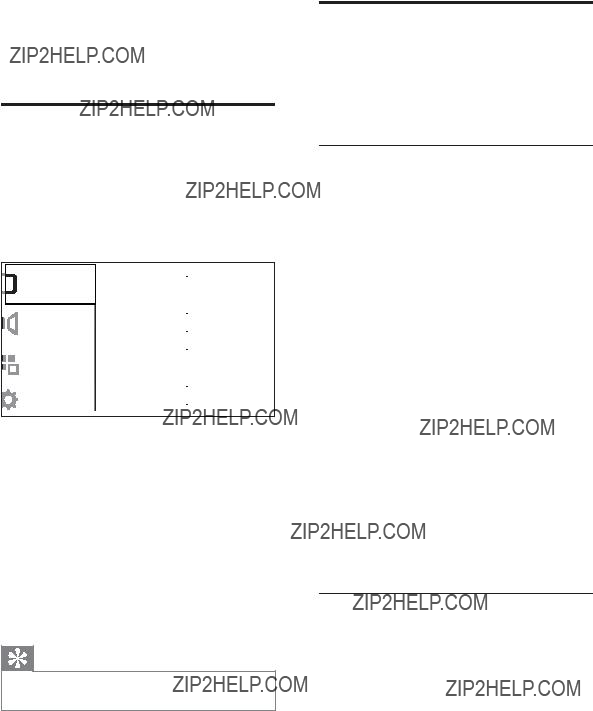
5Use more of your TV
Access TV menus
Menus help you to install channels, change picture and sound settings and access other features.
1 Press  MENU.
MENU.
?? The menu screen appears.
Change picture and sound settings
Change picture and sound settings to suit your preferences.You can apply
Use smart picture
Use smart picture to apply
1 Press  PICTURE.
PICTURE.
?? The [Smart picture] menu appears.
Picture
Sound
Features
Smart picture
Contrast
Brightness
Colour
Hue
Sharpness
Noise reduction
2 Press 
 to select one of the following smart picture settings.
to select one of the following smart picture settings.
Installation Tint
2 Press the 


 to select and navigate through one of the following menus.
to select and navigate through one of the following menus.
???[Picture]Adjusts the picture setting for optimal viewing.
???[Sound]Adjusts the sound setting.
???[Features]Accesses different features like timer, TV lock and demo.
???[Installation]Selects channel installation menu, adjusts preferences and resets the TV to factory settings.
3 Press OK to con???rm your choice.
Tip
???Press  MENU at any time to exit the menu.
MENU at any time to exit the menu.
???Press  BACK to move back one screen.
BACK to move back one screen.
3 Press OK to con???rm your choice.
??The selected smart picture setting is applied.
Manually adjust picture settings
1 Press  MENU.
MENU.
2 Press OK to select [Picture]. ?? The [Picture] menu appears.
3 Press 


 to select one of the following picture settings.
to select one of the following picture settings.
???[Smart picture]Accesses
???[Contrast]Adjusts the intensity of bright areas, keeping dark areas unchanged.
???[Brightness]Adjusts the intensity and details of dark areas.

???[Colour]Adjusts colour saturation.
???[Hue]Compensates colour variations in NTSC encoded transmissions.
???[Sharpness]Adjusts the level of sharpness in image details.
???[Noise reduction]Filters and reduces noise in an image.
???[Tint]Adjusts the colour balance in an image.
???[Custom tint]Make a customised tint setting.
???[Dig.CrystalClear]Digitally adjusts picture quality to optimal contrast, colour and sharpness.
???[Dynamic contrast]Automatically enhances contrast in an image. A [Medium] setting is recommended.
???[Dynamic backlight]Adjusts the brightness of the TV backlight to match lighting conditions.
???[MPEG artifact re.]Smooths out transitions on digital pictures. You can switch this feature on or off.
???[Colour enhancement]Makes colours more vivid and improves the resolution of details in bright colours. You can switch this feature on or off.
???[PC mode]Adjusts the picture when a PC is connected to the TV via HDMI/DVI/ VGA.
???[Picture format]Changes the picture format.
???[Horizontal shift]Adjusts the picture horizontally for
???[Vertical shift]Adjusts the picture vertically for
Change picture format
1 Press  FORMAT.
FORMAT.
?? A picture format bar appears.
2 Press 
 to select a picture format.
to select a picture format.
??The selected picture format is activated.
3 Press OK to con???rm your choice.
Summary of picture formats
The following picture settings can be con???gured.
 Note
Note
???Depending on the format of the picture source, some picture settings are not available.
English

[Auto format](Not for PC mode.) Enlarges the picture automatically to best ???t the screen. The subtitles remain visible.
[Super zoom](Not for HD and PC mode.) Removes the black bars on the side of 4:3 broadcasts. There is minimal distortion.
[4:3]Shows the classic 4:3 format.
[Subtitle zoom]Displays 4:3 pictures over the full area of the screen, with
[Movie exp.14:9](Not for HD and PC mode.) Scales 4:3 format to 14:9.
[Movie exp.16:9](Not for HD and PC mode.) Scales 4:3 format to 16:9.
[Wide screen]Stretches the classic 4:3 format to 16:9.
[Unscaled]For HD and PC mode only, and in selected models only. Allows maximum sharpness. Some distortion may
be present due to the broadcaster???s systems. Set your PC resolution to wide screen mode for best results.
12 EN
Use smart sound
Use smart sound to apply
1 Press  SOUND.
SOUND.
?? The [Smart sound] menu appears.
2 Press 
 to select one of the following smart sound settings.
to select one of the following smart sound settings.
???[Standard]Adjusts sound settings to suit most environments and types of audio.
???[NEWS]Applies sound settings ideally suited for spoken audio, such as the news.
???[MOVIE]Applies sound settings ideally suited for movies.
???[Personal]Applies the settings that were customised in the sound menu.
3 Press OK to con???rm your choice.
??The selected smart sound setting is applied.
Adjust sound settings
?? The [Sound] menu appears.
3 Press 


 to select one of the following sound settings.
to select one of the following sound settings.
???[Smart sound]Accesses
???[Bass]Adjusts the bass level.
???[Treble]Adjusts the treble level.
???[Volume]Adjusts the volume.
???[Balance]Adjusts the balance of the right and left speakers to best suit your listening position.
???[Dual
???[Mono/Stereo]Selects between mono or stereo if stereo is broadcast.
???[Surround]Enables spatial sound.
???[Auto volume]Automatically reduces sudden volume changes, for

example, when switching channels. When enabled, this produces a more consistent audio volume.
???[Delta volume]Levels out volume differences between channels or connected devices. Switch to the connected device before you change the delta volume.
Use advanced teletext features
Access the teletext options menu
Most of the advanced teletext features are
accessed via the teletext options menu.
1
2
3 Press 
 options.
options.
??? [Reveal]Hides or reveals hidden information on a page, such as solutions to riddles or puzzles.
??? [Cycle subpage]Cycles through subpages automatically if subpages are available.
??? [Language]Switches to a different language group to display a language correctly when that language uses a different character set.
??? [Freeze page]Freezes the current page.
4 Press OK to con???rm your choice and exit the teletext options menu.
Select teletext subpages
A teletext page can hold several subpages. Subpages are displayed on a bar next to the main page number.
1 Press MHEG/TELETEXT .
?? The teletext screen appears.
2 Select a teletext page with subpages.
3 Press  to enter a subpage.
to enter a subpage.
Table Of Pages (T.O.P.) teletext broadcasts allow you to jump from one subject to another without using page numbers. T.O.P. teletext is not broadcast on all TV channels.
1 Press MHEG/TELETEXT.
?? The teletext screen appears.
2 Press  INFO.
INFO.
?? The T.O.P. overview appears.
3 Press 


 to select a subject.
to select a subject.
4 Press OK to view the page.
Create and use lists of favourite channels
You can create lists of your preferred TV channels and radio stations so that you can ???nd those channels easily.
 Tip
Tip
???You can create and store up to four favourite lists on your TV.
Select a favourite list
1 When watching TV, press OK to display the channel grid.
2 Press  OPTIONS.
OPTIONS.
?? The channel options menu appears.
3 Press OK to select [Show favourite ch.].
?? The favourite lists appear.
4 Press 
 to select a favourite list.
to select a favourite list.
5 Press OK.
??Only channels in the favourite list appear in the channel grid.

View all channels
You can exit a favourite list, and view all installed channels.
1 When watching TV, press OK to display the channel grid.
2 Press  OPTIONS.
OPTIONS.
?? The channel options menu appears.
3 Select [Show favourite ch.] > [All] .
4 Press OK.
?? All channels display in the channel grid.
 Note
Note
???All favourite channels are marked by an asterisk in the channel grid.
Add a channel to a favourite list
 Tip
Tip
???View all channels before adding a channel to a favourite list.
1When watching TV, switch to the channel you want to add to a favourite list (see ???Switch channels??? on page 8).
2Press  OPTIONS.
OPTIONS.
??The channel options menu appears.
3Press 
 to select [Mark as favourite].
to select [Mark as favourite].
4Press OK.
??The favourite lists appear.
5Press 
 to select a favourite list to add the channel to.
to select a favourite list to add the channel to.
6Press OK.
??The channel is added to the favourite list.
Remove a channel from a favourite list
 Note
Note
???Select the favourite list to edit, before removing a channel.
1When watching TV, press OK to display the channel grid.
2Press  OPTIONS.
OPTIONS.
??The channel options menu appears.
3Press OK to enter [Show favourite ch.].
4Press 
 to select a favourite list and press OK to con???rm the choice.
to select a favourite list and press OK to con???rm the choice.
5Press 


 to choose the channel that you wish to remove from the list.
to choose the channel that you wish to remove from the list.
6Press  OPTIONS.
OPTIONS.
7Press 
 to select [Unmark as fav.].
to select [Unmark as fav.].
8Press OK.
??The channel is removed from the favourite list.
9Press  MENU to exit the channel options menu.
MENU to exit the channel options menu.
??The updated channel grid appears, displaying the current channels in the favourite list.
Use timers
You can set timers to switch the TV on or switch to standby at a speci???ed time.
Automatically switch the TV to standby (sleeptimer)
Sleeptimer switches the TV to standby after a
 Tip
Tip
???You can always switch off your TV earlier or reset the sleeptimer during the countdown.

1 Press  MENU.
MENU.
2 Select [Features] > [Sleeptimer] .
?? The [Sleeptimer] menu appears.
3 Press 
 to set the sleep time.
to set the sleep time.
??The sleeptimer can be up to 180 minutes in steps of ???ve minutes. If set to zero minutes, the sleeptimer is switched off.
4 Press OK to activate the sleeptimer.
??The TV switches to standby after the
Automatically switch the TV on (on timer)
You can switch the TV to a speci???ed channel at a speci???ed time, from standby.
and set the channel. 9 Press OK to con???rm. 10 Press  MENU to exit.
MENU to exit.
 Tip
Tip
???Select [On timer] > [Activate] > [Off] to disable [On timer].
???When [On timer] is [Off], only [Activate] can be selected.
???Set the TV clock before activating [On timer]feature (see ???Set the TV clock??? on page 16).
Use child control and rating locks
You can prevent your children from watching certain programmes or certain channels by locking the TV controls and by using ratings.
Set or change the TV lock code
1 Press  MENU.
MENU.
2 Press 


 to select [Features] > [Set code].
to select [Features] > [Set code].
3 Press  to enter the code setup.
to enter the code setup.
4 Enter your code using the Numeric buttons.
5
??If the code is set successfully, the dialogue box will disappear. However, if the code cannot be set, a new dialogue box will prompt you to
6 If you want to change the code, select
[Features] > [Change code].
7 Enter your current code using the
Numeric buttons.
??If the code is validated, a new dialogue box will prompt you to enter your new code.
8 Enter the new code using the Numeric buttons.
??A message appears prompting you to enter the new code again for con???rmation.
 Tip
Tip
???If you forget your code, enter ???8888??? to override any existing codes.
English

Lock or unlock all channels and connected devices
1 Press  MENU.
MENU.
2 Press 


 to select [Features] > [TV lock].
to select [Features] > [TV lock].
3 Press  to enter the [TV lock].
to enter the [TV lock].
??A screen appears prompting you to enter a code.
4 Enter your code using Numeric buttons. 5 Press 
 to select [Lock] or [Unlock]. 6 Press OK.
to select [Lock] or [Unlock]. 6 Press OK.
??All channels and connected devices are locked or unlocked.
7 Press  MENU to exit.
MENU to exit.
Note
???If you select [Lock], you have to enter your code every time you turn on your TV.
Lock or unlock one or more channels
1 When watching TV, press OK to display the channel grid.
2 Press 


 to select a channel to lock or unlock.
to select a channel to lock or unlock.
3 Press  OPTIONS.
OPTIONS.
4 Press 
 to select [Lock/Unlock chan.].
to select [Lock/Unlock chan.].
5 For each selection, press OK to lock or unlock the channel.
Use the TV clock
You can display a clock on the TV screen.
Set the TV clock
1 Press  MENU.
MENU.
2 Select [Features] > [Clock]
?? The [Clock] menu appears.
3 Press 


 or Numeric buttons to enter time.
or Numeric buttons to enter time.
4 Press [Done] to con???rm.
5 Press  MENU to exit.
MENU to exit.
Change TV preferences
1 Press  MENU.
MENU.
2 Select [Installation] > [Preferences] .
3 Press  to enter [Preferences].
to enter [Preferences].
???[Location]Optimises TV settings for your location - home or shop.
???[Volume bar]Displays the volume bar when adjusting the volume.
???[EasyLink]Enables
???[Colour] Sets the colour television standard used in your area.
???
4 Press 


 to select your preference. 5 Press OK.
to select your preference. 5 Press OK.
6 Press  MENU to exit.
MENU to exit.
Access decoder channel
You can map channels provided through a decoder or descrambler to your TV channel selection. In this way, you can select these channels by using the RC of your TV.The decoder or a descrambler must be connected to EXT1 or EXT2.
Set decoder channel
Map channels from a decoder or descrambler 1 Press  MENU.
MENU.
2 Select [Installation] > [Decoder] .
3 Press  to enter [Decoder].
to enter [Decoder].
4 Press  to enter [Channel].
to enter [Channel].

5 Press to select channel number to map to the decoder/descrambler channel.
to select channel number to map to the decoder/descrambler channel.
6 Press OK.
7 Press 


 to select and enter [Status].
to select and enter [Status].
8 Press 
 to select the connector used by the decoder/descrambler ([None], [EXT 1] or [EXT 2] .
to select the connector used by the decoder/descrambler ([None], [EXT 1] or [EXT 2] .
9 Press OK.
10 Press  MENU to exit.
MENU to exit.
 Note
Note
???Select [None] if you do not want to map to the decoder/descrambler channel.
???[EXT 2] is available only in TVs of 26 inches and larger.
Start a TV demo
1 Press  MENU.
MENU.
2 Select [Features] > [Demo] .
?? The [Demo] menu appears.
3 Press 
 to select a demo.
to select a demo.
???[Dig.CrystalClear]Displays two pictures side by side on the screen - a normal picture and a picture enhanced by this feature.
???[Active Control]Automatically adjusts the picture setting for optimal picture quality continuously under any signal conditions.
4 Press OK to start the demo.
5 Press  MENU to exit.
MENU to exit.
Reset the TV to factory settings
You can restore the default picture and sound settings of your TV. Channel installation settings remain the same.
1 Press  MENU.
MENU.
2 Select [Installation] > [Factory settings] .
3 Press  to enter the [Factory settings] menu.
to enter the [Factory settings] menu.
?? [Reset] is highlighted.
4 Press OK to reset to factory settings.
5 Press  MENU to exit.
MENU to exit.
English

6 Install channels
The ???rst time you setup your TV, you are prompted to select a menu language and to install TV and digital radio channels (if available). This chapter provides instructions on how to reinstall and ???ne tune channels.
Automatically install channels
This section describes how to search and store channels automatically.
Step 1 Select your menu language
Note
??? Skip this step if your language settings are correct.
1 Press  MENU.
MENU.
2 Select [Installation] > [Menu language] .
3 Press  to enter [Menu language].
to enter [Menu language].
4 Press 
 to select a language setting.
to select a language setting.
5 Press OK to con???rm.
6 Press  MENU to exit.
MENU to exit.
Step 2 Install Channels
Select your country for proper channel installation.
1 Press  MENU.
MENU.
2 Select [Installation] > [Channel install.] > [Channel assistant].
Preferences
Sound
Decoder
Factory settings
Features
Current software
Installation
3 Press 
 to select your country.
to select your country.
4 Press  to next step.
to next step.
5 Select [Start] and press OK to
Start automatic installation. This takes a few minutes.
Start?
??As the system searches for channels, you have the option to [Stop] the process.
6 If you want to stop searching, select [Stop] and press OK.
??A dialogue box appears asking you if you really want to [Stop] or [Continue] with the process.
7 Press 
 to select [Stop] or [Continue].
to select [Stop] or [Continue].
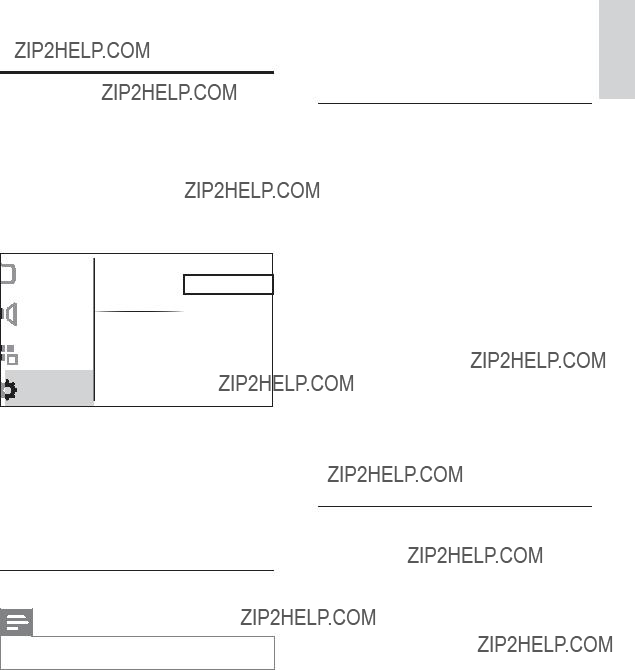
8 Press OK to con???rm your choice.
9 When done, press  MENU to exit.
MENU to exit.
Manually install channels
This section describes how to search and store analogue TV channels manually.
1 Press  MENU.
MENU.
2 Select [Installation] > [Channel install.] > [Analogue: Manual]
?? The [Analogue: Manual] menu appears.
Preferences
Sound
Decoder
Factory settings
Features
Current software
Installation
3 Press 
 to select the item you want to adjust.
to select the item you want to adjust.
???[System]
???[Search]
???
???[Store cur. chan.]
???[Store new channel]
Step 1 Select your system
Note
??? Skip this step if your system settings are correct.
1 Press  MENU.
MENU.
2 Select [Installation] > [Channel install.] > [Analogue: Manual]
?? The [Analogue: Manual] menu appears.
3 Press 


 to select and enter
to select and enter
[System].
4 Press 
 to select your country or region.
to select your country or region.
5 Press OK to con???rm.
6 Press  MENU to exit.
MENU to exit.
Step 2 Search and store new TV channels
1 Press  MENU.
MENU.
2 Select [Installation] > [Channel install.] > [Analogue: Manual].
?? The [Analogue: Manual] menu appears.
3 Press 


 to select and enter [Search].
to select and enter [Search].
4 Press 
 or use Numeric buttons to manually enter the three digit frequency.
or use Numeric buttons to manually enter the three digit frequency.
5 Press OK to begin search.
6 Press  when the new channel is found.
when the new channel is found.
7 Press 
 to select [Store new channel] to store the new channel under a new channel number.
to select [Store new channel] to store the new channel under a new channel number.
8 Press  to enter [Store new channel].
to enter [Store new channel].
9 Press 
 to select [Yes] and press OK to store the new channel.
to select [Yes] and press OK to store the new channel.
10 Press  MENU to exit.
MENU to exit.
Fine tune analogue channels
1 Press  MENU.
MENU.
2 Select [Installation] > [Channel install.] > [Analogue: Manual].
?? The [Analogue: Manual] menu appears.
3 Press 


 to select and enter [Fine- tune].
to select and enter [Fine- tune].
4 Press 
 to adjust frequency.
to adjust frequency.
5 Press OK when done.
6 Press 
 to select [Store cur. chan.] to store channel number.
to select [Store cur. chan.] to store channel number.
7 Press  to enter [Store cur. chan.].
to enter [Store cur. chan.].
8 Press 
 to select [Yes] and press OK to store current channel.
to select [Yes] and press OK to store current channel.
9 Press  MENU to exit.
MENU to exit.
English

Rename channels
Channels can be renamed so that a name of your choice appears whenever the channel is
selected.
1
2
3
4
Press 


 to select and enter [Rename chan.].
to select and enter [Rename chan.].
?? A text input box appears.
5
6
Press 


 to select characters.
to select characters.
Press OK to con???rm each of the characters.
 Tip
Tip
???Rename channels - the length of the name is limited to six characters.
???Use [Aa] to change
Rearrange channels
After you install channels, you can rearrange the
order in which they appear.
1
2
3
4
5
6
7
Press 


 to select and enter
to select and enter
[Reorder].
Select the channel you want to reorder and press OK.
Press 


 to select the new position for the channel.
to select the new position for the channel.
Press OK to con???rm the new position.
Press  OPTIONS.
OPTIONS.
?? [Done reordering] appears.
8 Press OK to ???nish reordering.
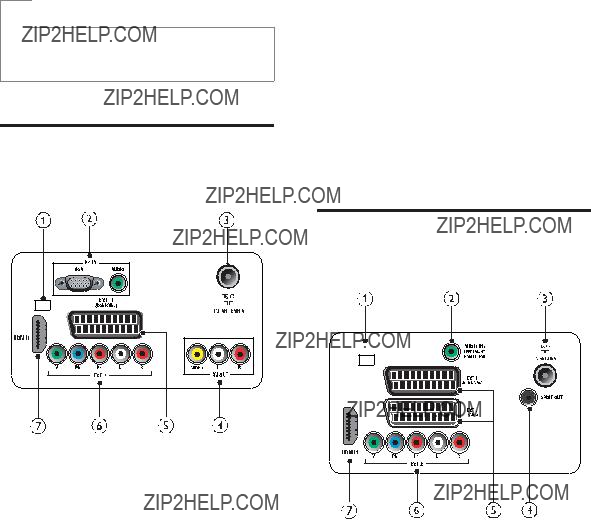
7 Connect devices
This section describes how to connect various devices with different connectors and supplements examples provided in the Quick Start.
 Note
Note
???Different types of connectors may be used to connect a device to your TV, depending on availability and your needs.
Back connector for
Back connector for TV 26 inch and larger
SERV.C
SERV.C
aSERV. C
For software update.
bPC IN (VGA and AUDIO IN)
Audio and video input from a computer.
cTV ANTENNA
Signal input from an antenna, cable or satellite.
aSERV. C
For software update.
bAUDIO IN
Audio input from devices that require a separate audio connection, such as a computer.
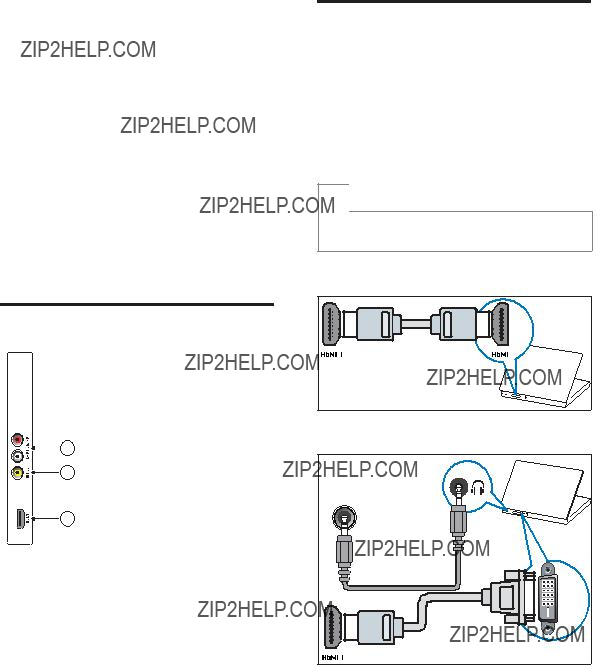
cTV ANTENNA
Signal input from an antenna, cable or satellite.
dSPDIF OUT
Digital audio output to home theatres and other digital audio systems.
eEXT 1 (RGB and CVBS)/EXT 2 (CVBS)
Analogue audio and video input from analogue or digital devices such as DVD players or game consoles. EXT 2 supports
fEXT 3 (Y Pb Pr and AUDIO L/R)
Analogue audio and video input from analogue or digital devices such as DVD players or game consoles.
gHDMI 1
Digital audio and video input from high- de???nition digital devices such as
Side connector
1
2
3
aAUDIO L/R
Audio input from analogue devices connected to VIDEO.
bVIDEO
Composite video input from analogue devices such as VCRs.
cHDMI (For TV 26 inch and larger)
Digital audio and video input from high- de???nition digital devices such as
Connect a computer
Before you connect a computer to the TV
???Set the screen refresh rate on your computer to 60Hz.
???Select a supported screen resolution on
your computer.
Connect a computer with one of the following connectors:
 Note
Note
???Connections via DVI or VGA require an additional audio cable.
???HDMI cable
???
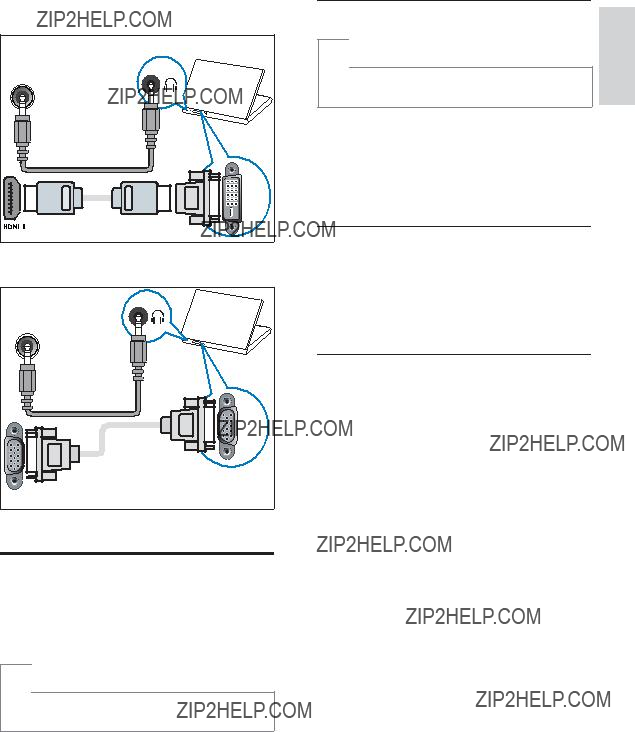
???HDMI cable and
???VGA cable
Enable or disable EasyLink
 Note
Note
???Do not enable Philips EasyLink if you do not intend to use it.
1 Press MENU.
2 Select [Installation] > [Preferences] >
[EasyLink].
3 Select [On] or [Off].
Use
1 After enabling EasyLink, press play on your device.
??The TV automatically switches to the correct source.
Use
1 Press and hold  Standby on the TV???s or device???s remote control for at least three seconds.
Standby on the TV???s or device???s remote control for at least three seconds.
??The TV and all connected HDMI devices switch to standby.
English
Use Philips EasyLink
Your TV supports Philips EasyLink, which enables
 Note
Note
???Compliant devices must be connected to your TV via HDMI.
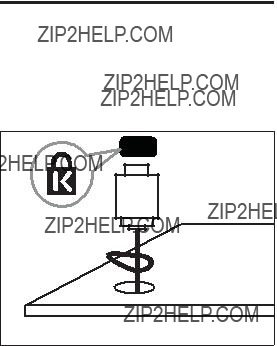
Use a Kensington lock
There is a Kensington security slot at the back of the TV. Prevent theft by looping a Kensington lock between the slot and a permanent object, such as a heavy table.

8Product information
Product information is subject to change without notice. For detailed product information, go to www.philips.com/support.
Supported display resolutions
Computer formats
???Resolution - refresh rate:
???640 x 480 - 60Hz
???800 x 600 - 60Hz
???1024 x 768 - 60Hz
???1280 x 1024 - 60 Hz
???1360 x 768 - 60Hz
???1440 x 900 - 60Hz (For Full HD only)
???1680 x 1050 - 60Hz (For Full HD only)
???Via HDMI/DVI input
Video formats
???Resolution - refresh rate:
???480i - 60Hz
???480p - 60Hz
???576i - 50Hz
???576p - 50Hz
???720p - 50Hz, 60Hz
???1080i - 50Hz, 60Hz
???1080p - 50Hz, 60Hz
???1080p - 24Hz, 25Hz, 30Hz, 50Hz, 60Hz.
Tuner/Reception/Transmission
???Antenna input: 75ohm coaxial (IEC75)
???TV system: PAL I, B/G, D/K; SECAM B/G, D/K, L/L???
???Video playback: NTSC, SECAM, PAL
???Tuner Bands: Hyperband,
VHF
Remote control
Power
???Mains power:
???Standby power: < 0.3W
???Ambient temperature: 5 to 40 degrees Celsius
Supported TV mounts
To mount the TV, purchase a suitable VESA- compatible TV mount and mounting bolts. For easy access to connectors, be sure to leave a clearance of at least 5.5 cm from the back of the TV.
 Warning
Warning
???Follow all instructions provided with your TV mount. Koninklijke Philips Electronics N.V. bears no responsibility for improper TV mounting that results in accident, injury or damage.

9 Troubleshooting
This section describes commonly encountered issues and accompanying solutions.
General TV issues
The TV does not switch on:
???Disconnect the power cable from the power outlet. Wait for one minute then reconnect it.
???Check that the power cable is securely connected.
The remote control is not working properly:
???Check that the remote control batteries are correctly inserted according to the +/- orientation.
???Replace the remote control batteries if they are ???at or weak.
???Clean the remote control and TV sensor
lens.
The standby light on the TV blinks red:
???Disconnect the power cable from the power outlet. Wait until the TV cools
down before reconnecting the power cable. If the blinking reoccurs, contact Philips Consumer Care.
You forgot the code to unlock the TV lock feature
???Enter ???8888???.
The TV menu is in the wrong language
???Change the TV menu to your preferred language.
When turning the TV on/off/to standby, you hear a creaking sound from the TV chassis:
???No action is required. The creaking sound is normal expansion and contraction of the TV as it cools and warms up. This does not impact performance.
TV channel issues
Previously installed channels do not appear in the channel list:
???Check that the correct channel list is selected.
Picture issues
The TV is on, but there is no picture:
???Check that the antenna is properly connected to the TV.
???Check that the correct device is selected as the TV source.
There is sound but no picture:
???Check that the picture settings are
correctly set.
There is poor TV reception from an antenna connection:
???Check that the antenna is properly connected to the TV.
???Loudspeakers, unearthed audio devices, neon lights, high buildings and other large objects can in???uence reception quality.
If possible, try to improve the reception quality by changing the antenna direction or moving devices away from the TV.
???If reception on only one channel is poor, ???ne tune this channel.
There is poor picture quality from connected devices:
???Check that the devices are connected properly.
???Check that the picture settings are correctly set.
The TV did not save your picture settings:
???Check that the TV location is set to the home setting. This mode offers you the ???exibility to change and save settings.
The picture does not ???t the screen; it is too big or too small:
???Try using a different picture format.

The picture position is incorrect:
???Picture signals from some devices may not ???t the screen correctly. Check the signal output of the device.
Sound issues
There is a picture but no sound from the TV:
 Note
Note
???If no audio signal is detected, the TV automatically switches the audio output off ??? this does not indicate malfunction.
???Check that all cables are properly connected.
???Check that the volume is not set to 0.
???Check that the sound is not muted.
There is a picture but the sound quality is poor:
???Check that the sound settings are
correctly set.
There is a picture but sound comes from one speaker only:
???Verify that sound balance is set to the centre.
HDMI connection issues
There are problems with HDMI devices:
???Note that HDCP support can delay the time taken for a TV to display content from a HDMI device.
???If the TV does not recognise the HDMI device and no picture is displayed, try switching the source from one device to another and back again.
???If there are intermittent sound disruptions, check that output settings from the HDMI device are correct.
???If a
Computer connection issues
The computer display on the TV is not stable:
???Check that a supported resolution and refresh rate is selected on the computer.
???Set the TV picture format to unscaled.
Contact us
If you cannot resolve your problem, refer to the FAQs for this TV at www.philips.com/ support.
If the problem remains unresolved, contact Philips Consumer Care in your country as listed in this User Manual.
 Warning
Warning
???Do not attempt to repair the TV yourself. This may cause severe injury, irreparable damage to your TV or void your warranty.
 Note
Note
???Make a note of your TV model and serial number before you contact Philips. These numbers are printed on the back of the TV and on the packaging.
English

O
P
R
S
T
V
English


?? 2009 Koninklijke Philips Electronics N.V. All rights reserved.
Document order number: P70G200001APHI